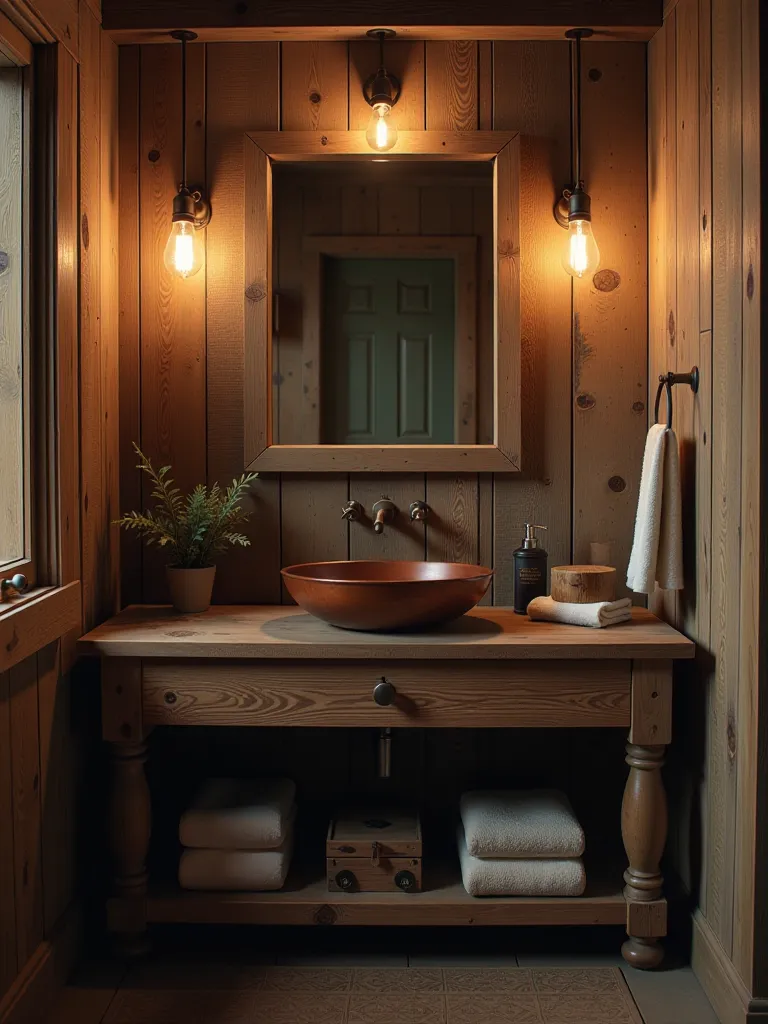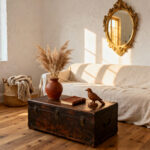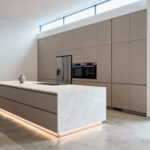Picture this: you’re standing in the heart of Milwaukee’s Historic Third Ward, surrounded by beautifully restored industrial buildings. Now, imagine bringing that same blend of history and modernity into your bathroom. That’s exactly what we’re going to explore today as we dive into the world of bathroom vanity materials. Just as our city has breathed new life into old structures, you too can transform your bathroom with the right vanity choice.
Did you know that the average person spends about 416 days of their life in the bathroom? That’s more than a year! With so much time spent in this intimate space, it’s crucial to choose bathroom vanity materials that not only look great but can stand the test of time. Whether you’re drawn to the warmth of reclaimed wood or the sleek lines of modern composites, there’s a perfect match for your vanity designs for your bathroom. So, let’s roll up our sleeves and explore the fascinating world of bathroom vanity materials, shall we?

Key Takeaways
Before we dive into the nitty-gritty, let’s highlight some key points to keep in mind:
- Choosing the right bathroom vanity materials is crucial for both durability and style. It’s like picking the perfect pierogi filling – it needs to satisfy your taste buds and keep you full!
- Popular materials like wood, laminate, and stone each have their unique charm and challenges. We’ll explore these in detail, much like how we’d compare the architectural styles of different Milwaukee neighborhoods.
- When evaluating the pros and cons, consider factors such as water resistance, maintenance needs, and cost. Think of it as choosing the right materials for a Lake Michigan beachfront property – it needs to withstand the elements!
- Your bathroom’s overall design should influence your choice of vanity material. It’s all about creating harmony, like a well-orchestrated polka band.
- Quality should always trump price. Investing in durable bathroom vanity materials is like investing in a solid foundation for a skyscraper – it pays off in the long run.
- Research and compare different options before making your final decision. It’s like planning the perfect Milwaukee brewery tour – you want to make sure you hit all the best spots!

Importance of Material Choice
Let’s face it, bathrooms are like the Great Lakes of our homes – water is everywhere! Different bathroom vanity materials handle moisture exposure in various ways. Take wood, for instance. It’s beautiful, but like an old Polish grandmother, it doesn’t always react well to humidity. It can warp or swell when exposed to too much moisture. On the flip side, materials like ceramic and glass are the Navy SEALs of the vanity world – they naturally resist water damage and are perfect for bathroom environments.
Ease of Cleaning
Now, I don’t know about you, but I’d rather spend my weekends exploring Milwaukee’s Riverwalk than scrubbing my bathroom vanity. That’s why it’s crucial to consider how easy your chosen material is to clean. Some bathroom vanity materials, like quartz and solid surface options, offer non-porous surfaces that make cleaning a breeze. They resist stains and grime buildup like a champ, making them the perfect choice for busy households or those of us who’d rather be out enjoying a Brewers game than stuck at home with a scrub brush.

Effect on Longevity
When it comes to bathroom vanity materials, longevity is key. It’s like choosing a building to renovate in the Historic Third Ward – you want something with good bones that will last for generations. High-quality materials withstand wear and tear better than cheaper alternatives, much like how our city’s cream city brick has stood the test of time. Remember, factors like humidity and temperature changes can affect durability too. Regular maintenance can extend the life of any material, just like how proper care has kept Milwaukee’s iconic Pabst Theater looking stunning after all these years.
Budget Considerations
Let’s talk money, honey. Just like there’s a range of home prices across Milwaukee neighborhoods, there’s a spectrum of costs when it comes to bathroom vanity materials. Luxurious materials often come with a higher price tag, but remember – balancing initial investment with long-term value is crucial. It’s like choosing between renting and buying a home. Sometimes, spending a bit more upfront can save you money in the long run. But don’t worry if you’re on a tight budget! Options like laminate provide wallet-friendly choices without sacrificing quality. It’s all about finding that sweet spot between cost and durability.

Common Vanity Materials
Let’s start with the underdog of bathroom vanity materials: particle board. Made from wood chips and resin, it’s the Polish sausage of the vanity world – affordable and gets the job done. Many manufacturers use this material due to its low cost, making it a popular choice for budget-friendly bathroom vanities. However, like a paper map in a rainstorm, particle board is susceptible to moisture. It can swell or warp when exposed to water, potentially leading to damage. If you’re considering a narrow bathroom vanity for a tight space, particle board could be a cost-effective option, but be aware of its limitations.
MDF Characteristics
Next up is MDF, or Medium Density Fiberboard. Think of it as the smooth jazz of bathroom vanity materials – dense, composed, and versatile. Its smooth surface makes it ideal for painting and finishing, allowing for a wide range of design possibilities. Many homeowners prefer MDF for its adaptability, much like how Milwaukeeans adapt to our ever-changing weather. However, like our lakefront during a storm, MDF can suffer from water damage if not properly sealed. It’s a step up from particle board in terms of durability but still requires careful consideration in moisture-prone areas.

Plywood Benefits
Ah, plywood – the unsung hero of bathroom vanity materials. With its layered construction, plywood is like a well-planned city grid: strong and resistant to warping. This material can withstand the test of time better than its engineered wood cousins, making it a popular choice among builders. Plywood’s versatility allows it to be used in various design applications, from sleek modern vanities to more traditional styles. It’s the chameleon of vanity materials, able to adapt to almost any design vision you might have for your bathroom oasis.
Solid Wood Features
Last but certainly not least, let’s talk about solid wood. If bathroom vanity materials were a Milwaukee neighborhood, solid wood would be the Historic Third Ward – timeless, charming, and full of character. With its natural beauty and unique grain patterns, solid wood offers a warmth that’s hard to beat. It’s robust and can withstand wear over time, much like the sturdy brick buildings that line our city streets. Many people appreciate solid wood for its timeless appeal but remember – like any historic property, it requires regular maintenance to prevent moisture damage and ensure it lasts for generations to come.

Pros and Cons of Each Material
Let’s dive into the world of particle board, shall we? This budget-friendly option among bathroom vanity materials is like the corner pub of the vanity world – accessible and gets the job done.
Pros:
- Affordability: It won’t break the bank, leaving you with more cash for that dream spa shower.
- Easy installation: Perfect for DIY enthusiasts or those who’d rather spend their weekend at Summerfest than wrestle with a complex vanity install.
Cons:
- Limited durability: It’s not the marathon runner of bathroom vanity materials.
- Poor water resistance: In a bathroom, that’s about as useful as an umbrella made of tissue paper.
Particle board is best suited for low-traffic bathrooms or as a temporary solution. It’s like a starter home – great to begin with, but you might want to upgrade eventually.

MDF Advantages and Drawbacks
Moving on to MDF, or as I like to call it, the chameleon of bathroom vanity materials. It’s versatile, like a Milwaukeean who can navigate both a Brewers game and an art gallery opening with equal ease.
Pros:
- Smooth finish: It takes paint like a dream, allowing for endless customization options.
- Moderate cost: It strikes a nice balance between quality and affordability.
Cons:
- Moisture sensitivity: It’s not a fan of water, much like how we’re not fans of January blizzards.
- Potential for swelling: When exposed to water, it can lose its shape faster than a snowman in spring.
MDF is a great choice for those who want a custom look without breaking the bank. Just be sure to keep it well-sealed and protected from excess moisture.

Plywood Strengths and Weaknesses
Ah, plywood – the unsung hero of bathroom vanity materials. It’s like a reliable friend who’s always there to help you move.
Pros:
- Durability: It can take a beating and keep on ticking.
- Resistance to cracking: It’s tougher than trying to find parking during Summerfest.
Cons:
- Higher cost: Quality comes at a price, much like our favorite craft beers.
- Potential for delamination: If exposed to excessive moisture, it can separate like Fairweather Packers fans after a losing season.
Plywood is an excellent choice for those who want a balance of durability and cost-effectiveness. It’s particularly well-suited for double bathroom vanity design styles, offering the strength needed for larger installations.

Solid Wood Upsides and Downsides
Last but not least, let’s talk about solid wood – the cream city brick of bathroom vanity materials. It’s classic, beautiful, and stands the test of time.
Pros:
- Aesthetic appeal: It adds warmth and character, like a cozy fireplace on a cold Wisconsin night.
- Longevity: With proper care, it can last longer than our winters feel.
Cons:
- High cost: Quality comes with a price tag, much like lakefront property.
- Maintenance requirements: It needs regular TLC, similar to how we need to protect our skin from both summer sun and winter wind.
Solid wood is perfect for those who appreciate natural beauty and are willing to invest in long-lasting quality. It’s ideal for creating a luxurious, spa-like bathroom atmosphere.

Selecting the Right Material
When it comes to choosing the right bathroom vanity materials, it’s crucial to assess your needs like a city planner evaluating a new development project. First, consider the traffic in your bathroom. Is it a busy hub like Brady Street on a Saturday night or more of a quiet retreat like the Lynden Sculpture Garden? High-traffic bathrooms need durable materials that can withstand constant use.
Next, think about your personal style preferences. Are you drawn to the warmth of traditional designs, or do you lean towards sleek, modern aesthetics? Your choice of bathroom vanity materials should reflect your taste and complement the overall design of your space. It’s like choosing the right architectural style for a building renovation in the Historic Third Ward – it needs to fit in while still standing out.
Don’t forget to evaluate durability against cost. Sometimes, investing in premium building materials pays off in the long run, much like how investing in quality insulation can save on energy costs during our harsh Wisconsin winters. Remember, the goal is to create a vanity that’s not just beautiful, but functional and long-lasting too.

Comparing Material Durability
When it comes to durability, not all bathroom vanity materials are created equal. It’s like comparing the staying power of different Milwaukee landmarks. Solid wood, for instance, is like the Pabst Theater – with proper care, it can last for generations. It offers longevity that engineered alternatives often can’t match.
On the other hand, engineered materials like MDF or particle board are more like pop-up beer gardens – they serve a purpose but may not withstand daily use as well over the long term. However, high-quality engineered options can still offer impressive durability.
Consider how different materials handle moisture exposure. Laminate might warp in high-humidity environments, while solid wood or properly sealed engineered materials can resist damage better. It’s like choosing materials for a Lake Michigan beachfront property – you need something that can handle the elements.
Here’s a quick ranking of bathroom vanity materials by their ability to handle wear and tear:
- Solid wood
- High-quality plywood
- MDF (when properly sealed)
- Laminate
- Particle board

Remember, the most durable option isn’t always the best choice for everyone. It’s about finding the right balance for your specific needs and budget.
Budget and Style Alignment
Now, let’s talk about aligning your budget with your style aspirations. It’s like planning a night out in Milwaukee – you want to have a great time, but you also need to keep your wallet in mind.
When choosing bathroom vanity materials, it’s important to remember that some options are more affordable but may lack the durability of pricier alternatives. However, that doesn’t mean you can’t achieve a stylish look on a budget. For instance, a well-chosen laminate vanity can mimic the look of natural stone or wood at a fraction of the cost.
Try to align your vanity material with your overall bathroom design and décor choices. A cohesive look enhances the space’s appeal, much like how the consistent cream city brick architecture creates a unified look in many Milwaukee neighborhoods.
Weigh the trade-offs between cost, style, and functionality carefully. Sometimes, a less expensive choice can still meet your aesthetic goals without sacrificing quality. It’s like finding that perfect happy hour spot – great ambiance, delicious food, and prices that won’t break the bank.

Remember, investing in quality bathroom vanity materials is like investing in a good winter coat in Wisconsin – it might cost more upfront, but it’ll serve you well for years to come.
Final Remarks
As we wrap up our journey through the world of bathroom vanity materials, I’m reminded of how selecting the right vanity is much like choosing the perfect spot for a new development in our beloved Milwaukee. It requires careful consideration, an eye for detail, and a balance between aesthetics and practicality.
Whether you’re drawn to the timeless appeal of solid wood, the affordability of engineered materials, or the sleek look of modern composites, remember that each option has its unique charm and challenges. It’s about finding that perfect match for your style, needs, and budget – just like finding your ideal neighborhood in our diverse city.
Don’t be afraid to take your time with this decision. Consult with experts, visit showrooms, and maybe even take a stroll through some of Milwaukee’s beautifully renovated historic buildings for inspiration. Your bathroom deserves a vanity that not only looks great but stands the test of time, much like our city’s iconic cream city brick architecture.
And remember, no matter which of the bathroom vanity materials you choose, it’s the love and care you put into your space that truly makes it special. So go ahead, and dive into this project with the same enthusiasm we Milwaukeeans have for our summer festivals. Create a bathroom that reflects your personality, meets your daily needs, and makes you smile every time you walk in.
After all, in the grand design of your home, your bathroom vanity is like the Milwaukee Art Museum of your personal space – functional, beautiful, and a true reflection of your style. So here’s to creating bathrooms that are as diverse, vibrant, and welcoming as our great city itself. Cheers to your next great bathroom adventure!






